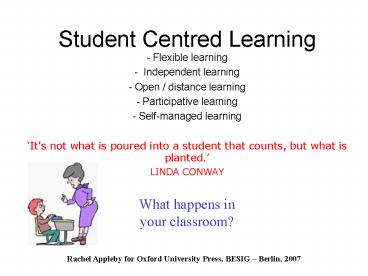Student Centred Learning - PowerPoint PPT Presentation
1 / 18
Title:
Student Centred Learning
Description:
It's not what is poured into a student that counts, but what is planted.' LINDA CONWAY ... O'NEILL AND TIM MCMAHON, UNIVERSITY COLLEGE DUBLIN. Continuum ... – PowerPoint PPT presentation
Number of Views:55
Avg rating:3.0/5.0
Title: Student Centred Learning
1
Student Centred Learning
- Flexible learning
- Independent learning
- Open / distance learning
- Participative learning
- Self-managed learning
- It's not what is poured into a student that
counts, but what is planted. - LINDA CONWAY
What happens in your classroom?
Rachel Appleby for Oxford University Press, BESIG
Berlin, 2007
2
Student Centred Learning (SCL)
- What does it really mean?
With SCL, sts are responsbile for planning the
curriculum or at leat they participant inthe
choosing.. The individual is 100 responsible for
his own behavious, participation and
learning. BRANDES AND GINNIS, (198612)
I know I cannot teach anyone anything. I can only
provide the environment in which he can
learn CARL ROGERS (1969)
3
SCL Overview
- Clarification
- Implications
- SCL in practice
- Making decisions
- Pitfalls
- Reaching a happy medium
- Action!
4
http//apu.gcal.ac.uk/ciced/Ch06.html ref.
Glasgow, Caledonia University
Basically....
5
Sources of theory / issues
- Needs analysis and Syllabus design
- John Munby
- Communicative language teaching
- Motivation (MacGregor) learner styles
6
Issues for SCL
Beliefs about learning ?
How can we find out? How can sts engage in
learning? How can we involve them? How can sts
be encouraged to try things out and discover?
What is the Teachers role?
Students learn in different ways Learning is
an active dynamic process Sts respond well if
they are involved People learn with guidance, not
prescriptions Knowledge is internal
individuals build it.
7
So, where does this leave us with SCL?
- ASK students what they want
- questions, questionnaires, NAs
- Empower students
- give them choice ensure high learner
control - Promote discussion
- and negotiate input / methodology
- Focus on student outcomes
- ... not on teaching
8
Benefits of SCL
- Students
- can work alone / in small groups, at school /
home - have access to more materials
- are involved in what they studies
- take ownership of their learning
- are more motivated and committed
- Teachers
- act as facilitators / guides
- help sts to work out learning strategies
- develop sts research ability
Source McLean (1997) Educational Initiative
Centre (2004)
9
Continuum
GERALDINE ONEILL AND TIM MCMAHON,
UNIVERSITY COLLEGE DUBLIN
10
Continuum
- T takes unilateral decisions
- T proposes, then consults Sts
- T consults with Sts, then makes a proposal
- Sts consult with T, then make a proposal
- Sts make a proposal, then consult with T
- Sts together make autonomous decisions
?
?
?
?
?
11
The Curriculum Pyramid
task
unit
book
CB other activities
syllabus
curriculum
LITTLEJOHN, A.
12
The Curriculum Pyramid
- LEVEL control
- Start at the top... work slowly
- Decision ? action ? review ? decision
- School / Government decisions
-
A. LITTLEJOHN
Thinking hard about the various options open to
us at each level of the pyramid is the first step
to finding ways of sharing decisions with
students.
13
Pitfalls
- Sts might feel the T doesnt know best
- St might feel role plays are too contrived / not
real - Expectations from sts can be very high
- Some sts feel its not their role to make a
choice - St commitment must be very high
- Some people cant adapt to a SCL style
- Some sts enjoy passive learning
- Ts may find it difficult to fulfill / accept
- Greater effort may be required from T. re
personalising - / providing FB to sts
14
Synthesis
- Flexible learning synthesis features of both
blended?
- integrated Teaching / Learning system,
incorporating the best features of both - built-in flexibility where sts have some say in
how when, where, what they learn - Inclusion of computer-based learning (eg CDRoms)
- ...and remember some sts enjoy passive learning!
15
Over to YOU!
- NEW INTERNATIONAL EXPRESS UPPER-INT
- 1 Look at the pages youve been given. Imagine
youre planning on using them with some sts next
week. What decisions could you involve the sts in
at ... - a) Task-level? b) CB / Unit-level?
- How would those decisions change your role /
planning / etc.?
- With the same unit in mind, think about how you
could assess your students using a SCL approach.
16
NEW INTERNATIONAL EXPRESS UPPER-INTERMEDIATE,
OUP Whats new??
- The good old stuff
- Combines general English with business
situations for Working,Travelling, Socializing - Includes a pocket book grammar summaries
- Is based on up-to-date topics, e.g.
- (new) U1 the first female space tourist
- Encourages communication and for sts to discuss
and share their ideas
17
NEW INTERNATIONAL EXPRESS UPPER-INTERMEDIATE,
OUP New
- Newly updated and revised (90 new material)
- Students audio CD with the Workbook
- A story line for the Focus on Functions which
develops through the book - Interactive Personal Language Trainer (Multi ROM)
- Word Power new vocabulary presented in context,
and (unit by unit) a list of new words with - - sound (audio) - word stress patterns
- - definitions - example sentence - related words
- Language Focus further activities to practise /
test - Focus on Functions activities to practise / test
18
Student Centred Learning
- involvement
- motivation
- ownership
Rachel Appleby for Oxford University Press, BESIG
Berlin, 2007































